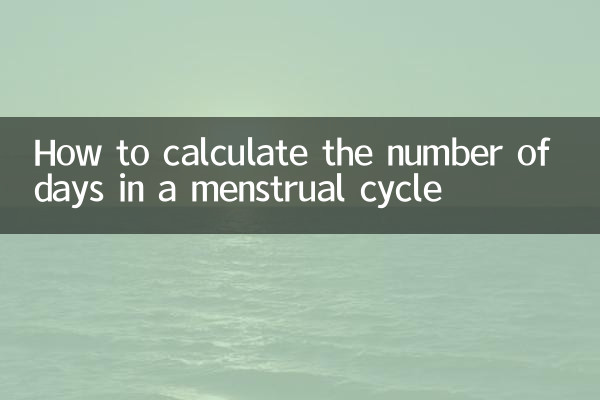How to calculate the number of days in a menstrual cycle
The menstrual cycle is one of the important indicators of female reproductive health. Accurately calculating the menstrual cycle not only helps to understand the physical condition, but also helps prepare for pregnancy or contraception. Recently, the topic of menstrual cycle calculation has sparked heated discussions on social platforms, with many women sharing their experiences and confusion. This article will detail how to calculate your menstrual cycle and provide structured data to help you better understand.
1. What is the menstrual cycle?

The menstrual cycle is the number of days between the first day of your period and the first day of your next period. A complete menstrual cycle is usually divided into the following phases:
| stage | days | Main features |
|---|---|---|
| menstrual period | 3-7 days | The endometrium sheds and menstrual bleeding occurs |
| follicular phase | 7-21 days | Follicles develop and estrogen levels rise |
| Ovulation period | 1-2 days | The egg is released and the chance of pregnancy is highest |
| Luteal phase | 10-14 days | The corpus luteum forms and progesterone levels rise |
2. How to calculate the menstrual cycle?
The steps to calculate your menstrual cycle are as follows:
1.Record the start date of menstruation: The first day of each menstrual period is recorded as the first day of the cycle.
2.Record continuously for 3-6 months: Since the cycle may fluctuate, long-term recording is recommended to improve accuracy.
3.Calculate the interval between the first days of two consecutive menstrual periods: For example, if this menstruation is on May 1st and the next menstrual period is on May 28th, the cycle will be 27 days.
3. Normal range of menstrual cycle
According to clinical studies, a healthy woman’s menstrual cycle typically falls within the following ranges:
| Classification | Day range | Proportion |
|---|---|---|
| normal cycle | 21-35 days | About 80% female |
| short cycle | <21 days | Need to be alert to ovarian function decline |
| long cycle | >35 days | Possible polycystic ovary syndrome |
4. Factors affecting the menstrual cycle
Recent hot search topics show that many women are concerned about the following factors that affect the menstrual cycle:
1.stress and emotions: Anxiety and depression may lead to cycle disorders.
2.Diet and weight: Excessive dieting or obesity can interfere with hormone balance.
3.exercise intensity: Athletes may experience "exercise-induced amenorrhea."
4.Diseases and Drugs: Such as thyroid disease, birth control pills, etc.
5. How to maintain a regular menstrual cycle?
Based on recent suggestions from health bloggers, the following methods are recommended:
| method | Specific measures | Effect |
|---|---|---|
| Regular schedule | Guarantee 7-8 hours of sleep | Stabilize hormone secretion |
| balanced diet | Supplement iron and B vitamins | Improve symptoms of anemia |
| moderate exercise | 150 minutes of aerobics per week | Promote blood circulation |
| Emotional management | Meditation, deep breathing exercises | Reduce stress hormones |
6. When do you need medical treatment?
If the following situations occur, it is recommended to consult a doctor in time:
1. The cycle suddenly changes for more than 7 days and lasts for more than 3 months
2. Menstrual period exceeds 10 days or abnormal menstrual blood volume
3. Amenorrhea for more than 3 months (not pregnant)
4. Accompanied by severe dysmenorrhea or irregular bleeding
By scientifically calculating and recording menstrual cycles, women can better control their physiological health. Recently popular health management apps (such as Clue and Flo) also provide intelligent tracking functions to help modern women manage their menstrual cycles more conveniently.

check the details

check the details